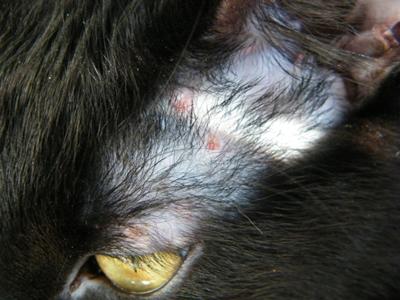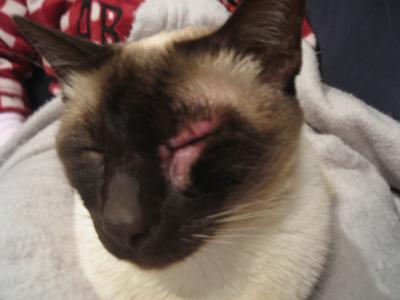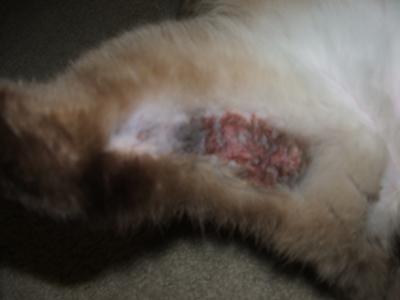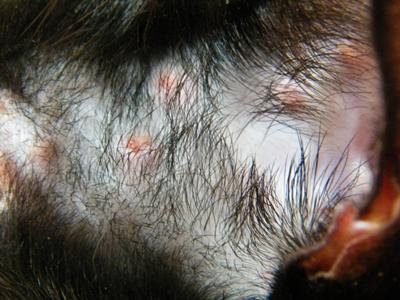Unknown Cat Skin Disorder
by Tony
(Illinois)
Cat Skin Disorder Reader Question: It started as a very small bump under the surface of the lower eyelid. It eventually progressed into hair loss around the corner of the eye and the skin became very pink and inflamed. It has now spread to the upper eyelid area with hair loss as well.
I have had him to three Veterinarians, all of which are unable to tell me exactly what the problem is. I am currently waiting for the results of a DTM (dermatophyte test medium). One of the Doctors scraped the area with a scalpel and also applied a type of tape to the area to collect a sample which was looked at through a microscope.
I was told that the hair shafts were "moth-eaten" which was indicative of a fungal-type of infection but nothing was conclusively determined.
I was initially given Prednisolone Acetate 1% and Erythromycin which I faithfully administered for approx. 1 week. His eye was actually getting worse so I discontinued those medications and started Clavamox and Itraconazole. It has been approximately 4 days and it doesn't seem to be helping.
Cosmo is a male 12 year-old Siamese who is approximately 12 lbs. He has never had any health issues and has always had a very beautiful coat. I have always given him quality food (Hill's Science Diet). I have recently changed formulas of food but not changed brands. I don't think the food change is relevant, but thought I should mention it. If anyone has had a similar problem please help. We are hoping this will soon heal but until then we are desperately seeking any advice or input. Please help!
Cat Skin Disorder: Cat Health Guide Editor Reply:
Dear Tony,
Sorry to hear about the skin disorder around your cat's eye.
There are several possible cat eye conditions related to the feline species, including infections, inflammation, worm infestation or even tumors.
Unfortunately, it is not possible to diagnose the condition through the picture or even through the symptoms and treatment approaches you mentioned.
However, there are some possibilities and points you should discuss with your veterinarian. It seems
All of these symptoms indicate that even if it was a minor condition earlier, the skin problem has developed into a relatively complicated case.
If inflammation in the eye is ever suspected, treatment should be applied that prevents swelling so that the eye remains open. The logic behind this approach is to prevent accumulation of debris, broken hairs, pus or any allergen behind the swollen eyelids.
So, you should preferably discuss this with your veterinarian and an approach to reduce swelling should be followed. This may be accomplished with steroids or any quality anti inflammatory ointment applied topically.
Secondly, it is most possible that it might be a fungal condition, as the tests suggest, but remember that fungal infections may also cause simultaneous eye infections, which should be diagnosed properly. Lesions, pus and redness of the eye can be noted. In the presence of inflammation, as in this case, it will be relatively harder to diagnose.
The drugs you have mentioned are effective, but your veterinarian must revise them to a more specific approach, i.e. drugs should be broad spectrum and both modes of administration (oral and topical) should be followed. Remember, topical application of specific drugs will only be successful once the inflammation has resolved itself, otherwise drugs may not get absorbed into the inner parts of the cat eyelid to act effectively.
Unfortunately, we cannot prescribe any specific drugs here; we can recommend some eye cleansers and herbal remedies, which you should apply regularly. Eye cleansers such as OptiClear Eye Wash
Sorry we couldn't be of more help. Please keep in touch and let us know how this case is cured.
Click here to read or post comments
Join in and write your own page! It's easy to do. How? Simply click here to return to Cat Skin.
Horrible Mystery Cat Skin Condition Please Help!!
by Katie
(Idaho)
Hi there,
Our 6 year old female cat has a HORRID skin condition that she has had since she was probably a year old. It starts as an itchiness, that she continues to madly scratch at her head and neck until they are raw, scabby, oozing and bleeding.
The first time I took her to the vet I was told it was an allergy and she got a Depomedrol shot. It kept her skin clear until the next spring. That was in 2006. Since that time, the shots have lost their effectiveness---so it used to be once a year, then twice, then three times and this last time the Depomedrol lost its effectiveness after just one month!!
I believe the shots have made her very overweight too. Believing it is an allergy, I have made the switch to grain free food---trying 2 expensive types that are having no effect. Her skin is SO bad now----her entire neck and chin are basically hairless, covered in oozing scabs. She has 2 patches over each eye/in front of each ear that are also bald, oozing, scabby and swollen.
She compulsively licks every type of medicine off, so I have been using a product called Sovereign Silver---an internal liquid and a topical first aid gel that seems to help. But not very fast, because if we miss ONE day, she gets itchy again and scratches the scabs off and re-starts the whole process.
The vet told me about a process for testing for 'allergies' that could 'possibly' identify what her problem is, and then I would have to give allergy shots, the process will take months and will cost about $300. The economy has been very tough on us and we are out of money for the vet right now (2 kids still at home and one close to college!).
I am hoping, hoping that SOMEONE will see this and know what it is. We LOVE this cat so much---she is so gentle and loving, but so miserable. If we can't come up with a solution that really works, I am afraid she will have to be put down because she is miserable the the bloody pus she sprays everywhere when she scratches is disgusting.
The pictures I have attached show how these spots start----as a redness to her skin that itches horribly and that she scratches at incessantly until they are bloody, oozing, swollen and scabby. That is the condition she is in now---and hence has found weird hiding places to avoid us attacking her with medicine and also because she feels bad. This is out of character for her, as we have always called her 'little doggie' because she always follows us around and keeps us company more like a dog.
Vet Suggestion Cat Skin Condition
Hi Katie,
I’m sorry to hear about what you and your cat have been going through.
I have to agree with your veterinarian. The description of your cat’s condition and progression of her symptoms could have come from a textbook about feline allergies. Here are a couple of ideas that you can try at home, but keep in mind that the allergy testing/shots may be necessary to save your cat if she has an allergy to pollen, molds, dust mites, or other environmental triggers.
Flea allergies are very common in cats. Even if you don’t see fleas, one or two might be all that it takes to set off your cat’s reaction. If your cat is not already on a monthly flea preventative, ask your veterinarian if he or she could prescribe Revolution. This product is extremely effective against fleas and has the additional benefit of killing some other types of microscopic parasites that could be to blame for your cat’s symptoms.
Food allergies may also be playing a role. You mentioned you tried several grain free cat foods, which might have worked if your cat was allergic to a grain, but protein sources are also very common allergens for cats. Try a food, ideally canned, with a protein source that your cat has never come in contact with (e.g., duck). Read the ingredient list to make sure that common protein sources (e.g., chicken) aren’t also included. Your veterinarian can provide you with a prescription hypoallergenic cat food if you have trouble finding an appropriate over-the-counter product.
In addition to what I’ve mentioned above, you can also try a topical product called Dermoscent or a homeopathic preparation designed to help with skin allergies in cats (e.g; Allergy Itch Ease).
Best of luck,
Jennifer Coates, DVM
Click here to read or post comments
Join in and write your own page! It's easy to do. How? Simply click here to return to Cat Skin.
Cat Skin Problem We Can't Figure Out
by Tonya
(San Antonio, TX)
This is Godzilla, he is a 15 month old snowshoe Siamese. I adopted him from a shelter about 4 months ago. When he arrived he was fine, no signs of this skin condition. About 2 months ago I noticed his inner back thigh had a large flat cat skin sore. He was licking constantly so it grew.
Took him to a vet and the Dr. initially thought it was a chemical burn, so got a topical powder and that wonderful collar to keep him from licking.
One and a half weeks later we were back at the vet with three more spots, one on his shoulder, front inner leg, and on the back of his neck all the same as the first. Starting out small and growing with the licking/chewing.
He has had a fungal culture, blood work to check for liver damage, and skin scraped to check for parasites. All are negative.
He is now on prescription food for a possible allergy. So far there is no improvement and in the last 24 hours it is getting worst again. He goes back to the vet tomorrow. I am open for any suggestions to bring to the vet. I love him and would like to make sure he around for a long time!!
Cat Skin Condition - Cat Health Guide Editor Suggestion
Dear Tonya;
Thank you for your question regarding cat skin allergy and hard to diagnose cat skin conditions and diseases.
Feline skin is the most exposed part of the body, thus it may develop various conditions or cat skin problems which are sometimes very hard to diagnose.
As you have described, various tests for this cat skin problem appeared negative, but symptoms, pathogenesis (cat skin disease progression) and follow up of the disease suggests that it is related to the immune system of your pet. Though this diagnosis can only be confirmed with a detailed examination and laboratory diagnosis, it seems that it is most probably what is referred to as an eosinophilic granuloma complex. The reason for this conclusion are the cat skin symptoms you described and that are shown in the picture - the burn like spots in the inner thighs of the hind quarter, and the negative results when tested for common cat skin conditions and pruritus (feline skin itch).
It is recommended that you try some different tests, such as a swab examination, CBC and detailed biopsy. The level of feline eosinophills should be examined in detail.
In addition to these tests, allergy tests, which can be performed in vitro (measures the antibodies that mediate an allergic response) or intra dermal (small amount of the allergen solution is injected into the skin) may also be required, which you should discuss with your veterinarian. The underlying cause of these types of symptoms is mostly a hypersensitivity reaction, which indicates some kind of allergy. It can be a food allergy, atopy (genetic predisposition to an allergy), insect bites, environmental etc.
Specific treatment of the cat skin condition is based upon the diagnosis. The underlying cause should be treated in order to control the symptoms.
Treatment is accomplished with corticosteroids and immuno – suppressant agents. Additionally, it is recommended that mild antibiotic therapy should be done, in order to prevent any secondary bacterial and fungal infections. It is better to use a restricted diet, but if possible, go for a food trial, to identify the ingredient possibly causing any allergy. Discuss this option with your veterinarian as well.
You can also use natural remedies such as Allergy Itch Ease to reduce symptoms such as itching and scratching. Also a natural skin cleanser will help to clean the skin and reduce any chance of localized spreading of the cat skin lesions. A good product to try is Clenzor.
Please keep us up to date on how resolved this cat skin allergy condition.
Click here to read or post comments
Join in and write your own page! It's easy to do. How? Simply click here to return to Cat Skin.
Cat Skin Condition Unknown Cause
by Adam F
(Quebec, QC, Canada)

Picture Possible Cat Skin Infection
My cat, Vegas, is a male neutered cat who has tiny infected spots around his eyes, forehead and ears resembling human acne. He is a year and a half old. We don't have any other animals in the house other than fish. He is a 100% indoor cat. We've had him checked for fleas, ticks, and ear mites and there has been no evidence of anything like that. The vet gave him an injection antibiotic which temporarily cured the problem but it came back soon after.
These spots heal on their own but come back often. The spots start as a colorless bump, then turn red, and scab. Eventually the scab falls off and the spot heals and the hair around it grows back.
Editor Suggestions Cat Skin Infection or Other Cause
Dear Adam,
What a handsome kitty!
It sounds like Vegas has a skin infection (since it went away with the antibiotic injection) but usually these occur because of another underlying problem, which is why they come back once antibiotics are stopped.
The list of possible underlying conditions is long and includes environmental allergies, food allergies and intolerances, mite infestations, etc.
Your veterinarian or a veterinary dermatologist would need to run some diagnostic tests and/or try some empiric treatment to figure out exactly what is going on.
If you want to try something yourself, you could change your cat’s diet to one that is hypoallergenic or designed to help with skin sensitivities.
Good luck,
Jennifer Coates, DVM
Click here to read or post comments
Join in and write your own page! It's easy to do. How? Simply click here to return to Cat Skin.







